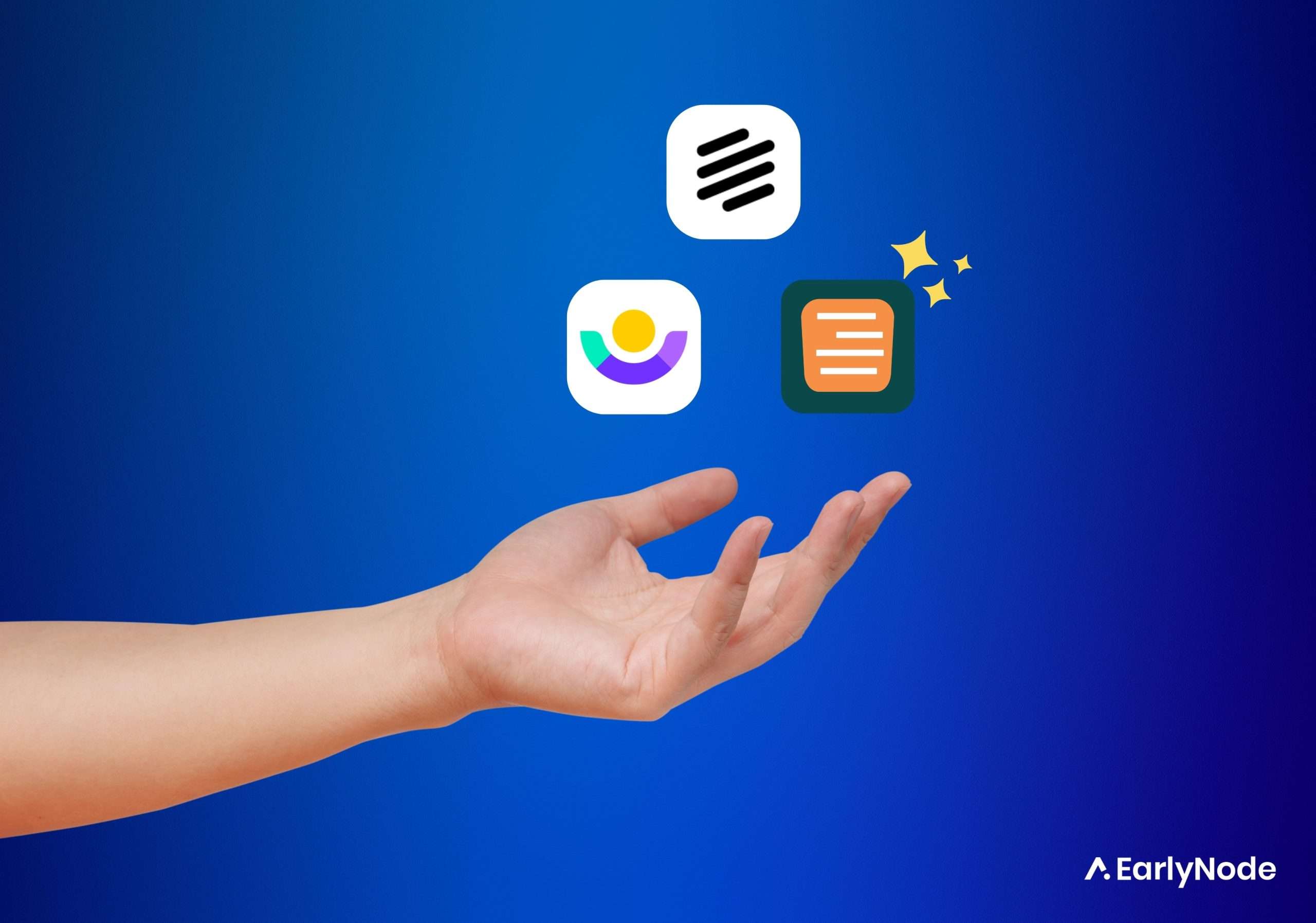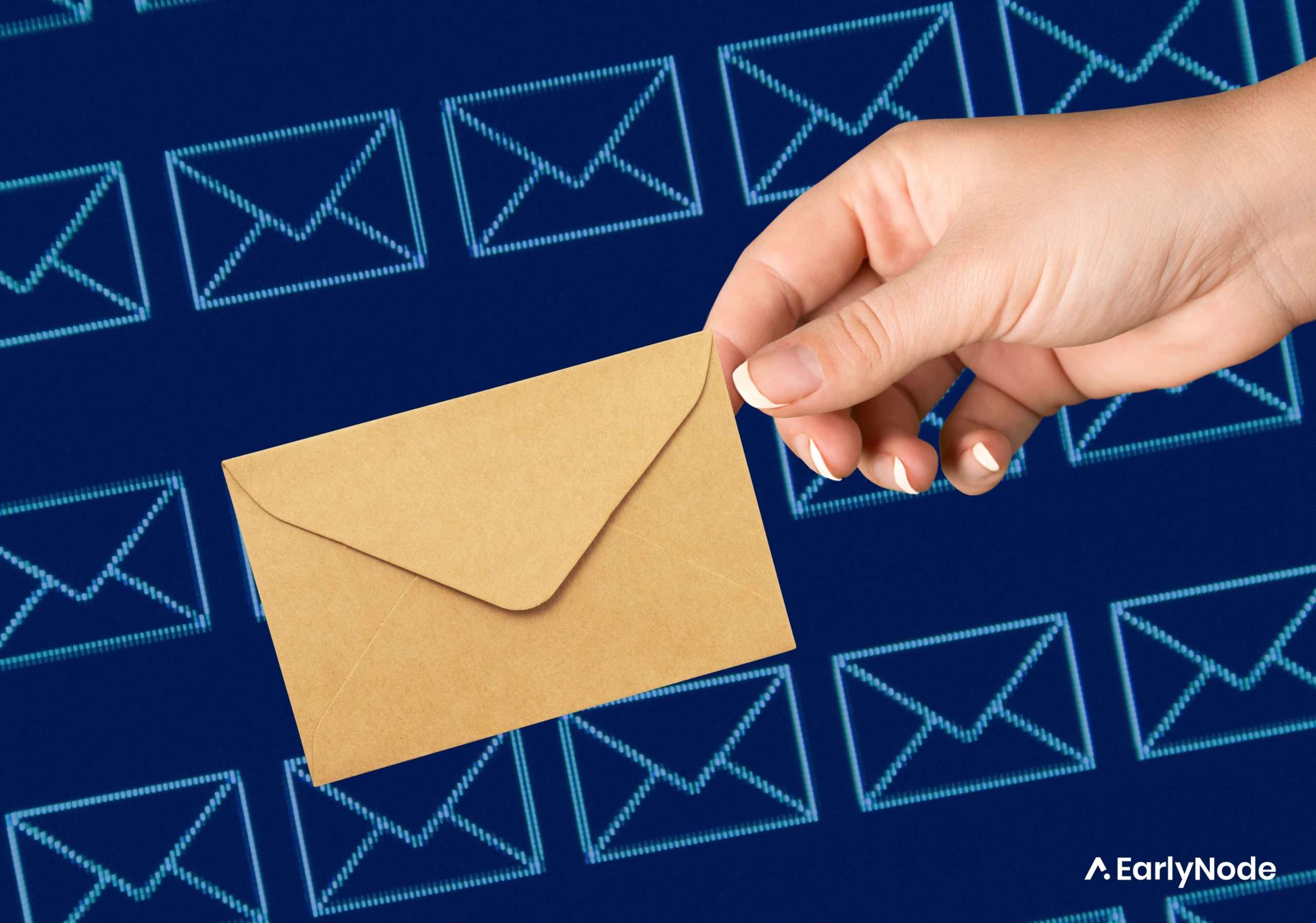SaaS Release Notes Templates: 5 Great Examples For Inspiration
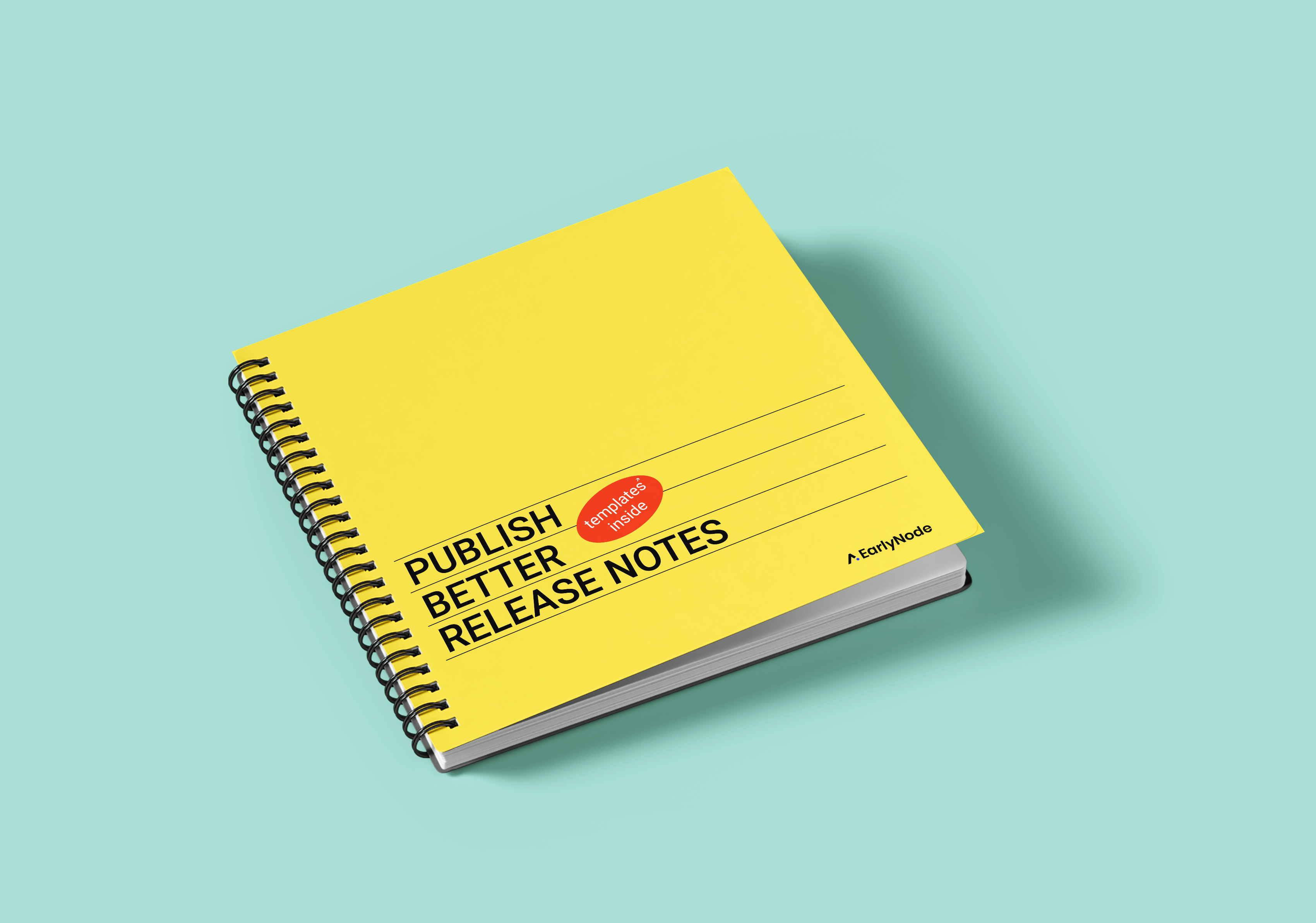
TL;DR
- Release notes are necessary for SaaS to communicate product changes to their end users.
- A good SaaS release note intrigues users to read, engage, and take action.
- There are three types of release notes based on the changes: New features, enhancements, and bug fixes.
- There are five ways to distribute release notes: emails, social media, blog, standalone changelog, and in-app changelog.
- Producing release notes from scratch every time can be a daunting task. But using templates can help save a lot of time and effort.
- Templates keep your format clear and consistent. This helps to communicate better with your customers.
SaaS release notes – Why are they necessary?
If you invest a lot of time and resources into developing new features, it makes sense to announce them so that customers discover, use and adopt these features.
Release notes play a major role in communicating to your users that you value their feedback and are looking to improve create a more quality product.
Some SaaS companies publish release notes as an afterthought- no structure, just plain content and so it appears ineffective.
If you want to write and design an effective release note here’s a simple, concise, template you can copy and paste.
A Copy/Paste SaaS Release Note Template
This template works for changelog posts for new feature announcements. If you want templates for other forms of release notes, they’re all listed below.
You can edit the template by inserting custom values in brackets {}.
{Date}
{Header Goes Here – Choose any of the following or come up with a creative and catchy header}
- {New Feature} is officially out.
- Introducing the all-new {New Feature}.
- Now you can {Function} with {New Feature}.
{Write 2-3 sentences introducing your new feature here}
- Make it exciting and conversational.
- Start with something like Great News or Heads Up, etc.
{Embed an educational resource here. It could be a video, image, or a GIF}
- Show your new feature in action.
- This resource must tell customers how to access the feature, too.
{Desctibe benefits of this feature for users. You can list them out as bullets or in a paragraph. Take 100 words at most}
- Make it conversational by talking about your customer’s benefits instead of what your new feature can do.
{Take 30-40 words to describe how this feature gets the job done and any known limitations to its functions}
- Here you can talk about what your feature exactly does. (keep it short though)
- List out all the functions.
- Also talk about functions you’re working on. (if any)
{A strong CTA – Choose any of the following or go with something persuasive}
- Click here to try {New Feature} today.
- Check out {New Feature} now.
- Try out {New Feature}.
So, there you have it – a simple template for you to kick off your release note production. Here’s a little visual aid.
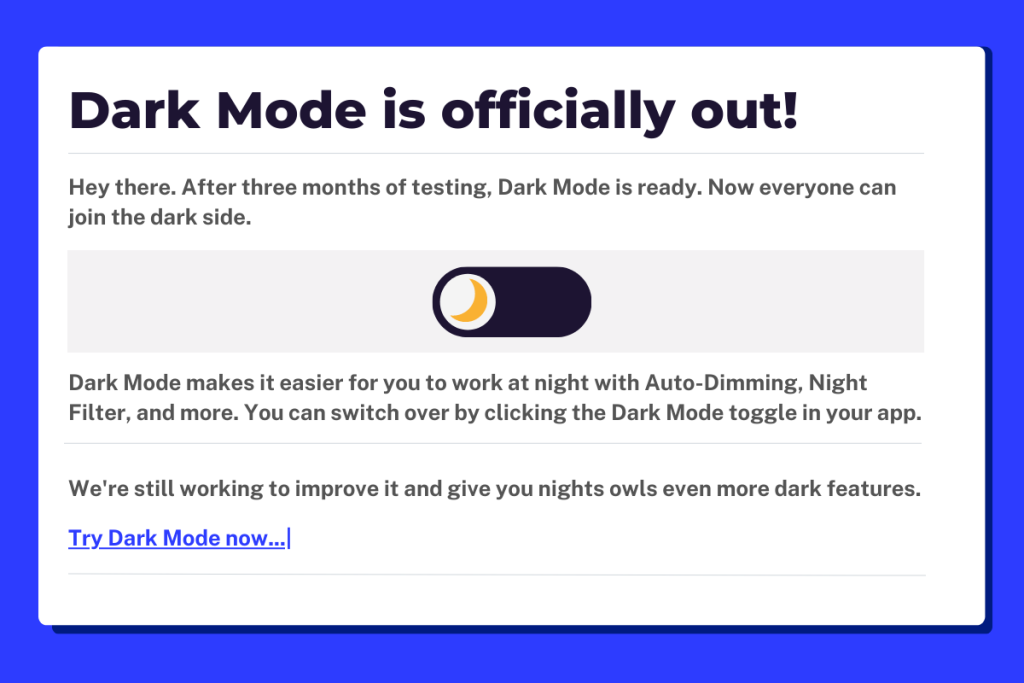
Types of release notes
The template above checks all the boxes for a good release note about new features. But what if you want to announce bug fixes or enhancements instead of new features?
We modified this template for other use cases too.
#1 Feature enhancements template
Updating your product’s features or making UI improvements is a regular task in the SaaS industry.
And because there is customer feedback coming in from all directions, you have to make the changes quickly then announce them. For that, you need to write a release note.
Here’s a template to help you prepare a good announcement covering everything about an enhancement. (Insert custom values in the {})
{Date}
{Header Goes Here – Choose any of the following or come up with a creative and catchy header}
- New and improved {Feature name}.
- {Feature name} just got its new look.
- {Function} has been added to the {Feature name}.
{Write 1-2 sentences describing what’s changed}
- Describe what your customers can now do that they couldn’t before.
{Embed an educational resource here describing the change. It could be a video, image, or GIF.} (OPTIONAL)
- If added, keep the video or GIF short and to the point.
- Your customers already know the feature so just talk about or show the additional functions in action.
{List out all the improvements made to the feature. Take 50-60 words to describe what exactly you have improved}
- Use one-liners to talk about the jobs that can be done with all the newly added functions.
{Describe how this improvement benefits users. Take 50 words at most}
- Show the value these improvements bring to the table.
{Take 10-20 words to thank users for their feedback or ask them what else would they like to see in the improved feature}
{A strong CTA asking them for feedback or to check out the improved feature- Choose any of the following or go with something persuasive}
- Enjoy the improved {Feature name} here.
- Do {New Function}.
- Try our new {Feature name}.
#2 Bug fix template
Where there is software, there are bugs. And when dealing with these bugs, it’s better to communicate with your users regularly and consistently.
This builds and maintains a level of trust and shows that you’re devoted to lifting their experience.
Here’s a template for writing a good bug fix release note:
{Date}
{Header Goes Here – Choose any of the following or come up with a creative and catchy header}
- {Feature name} is up and running again.
- {Feature name} is back to normal.
- {Feature name} is fixed.
{Write 1-2 sentences about what was broken and reported}
- Example: “It was reported that Dark Mode has been acting up…”
{Describe when it happened and who was impacted in 1-2 sentences}
- Example: “Last weekend, some premium plan users had difficulty turning on the Dark Mode…”
{Embed an educational resource here. It could be a video, image, or a GIF} (OPTIONAL)
{Describe how the fix impacts users. Take 50-60 words at most}
{Take 5-10 words to thank users for reporting the issue.}
- Example: “We thank our dark side avengers for… ”
{A strong CTA to the fixed feature – Choose any of the following.}
- Check out the fixed {Feature name}.
- You can enjoy {Feature name} now.
5 Ways To Distribute SaaS Release Notes And How.
Now you have templates to work with, but you still need to inform users about the new features and product enhancements.
You need to drive new feature adoption and to do that, you need to use multiple channels to meet your different users online.
So, here are the five channels you can distribute your release notes and how you can do it for maximum results:
In-app messaging
This is the most effective way to get your latest features in front of your users.
You can distribute release notes inside the app in three different ways:
- With an announcement banner at the top
- With a slideout
- With a tool tip announcement
The announcement banner at the top part of your app is to draw attention to new product launches. You can use the original header of the release note here and include a link to a detailed blog post about the release.
Slideouts are a good way to get your message in front of more app users. Because you can display your release notes on every page without being overly intrusive.
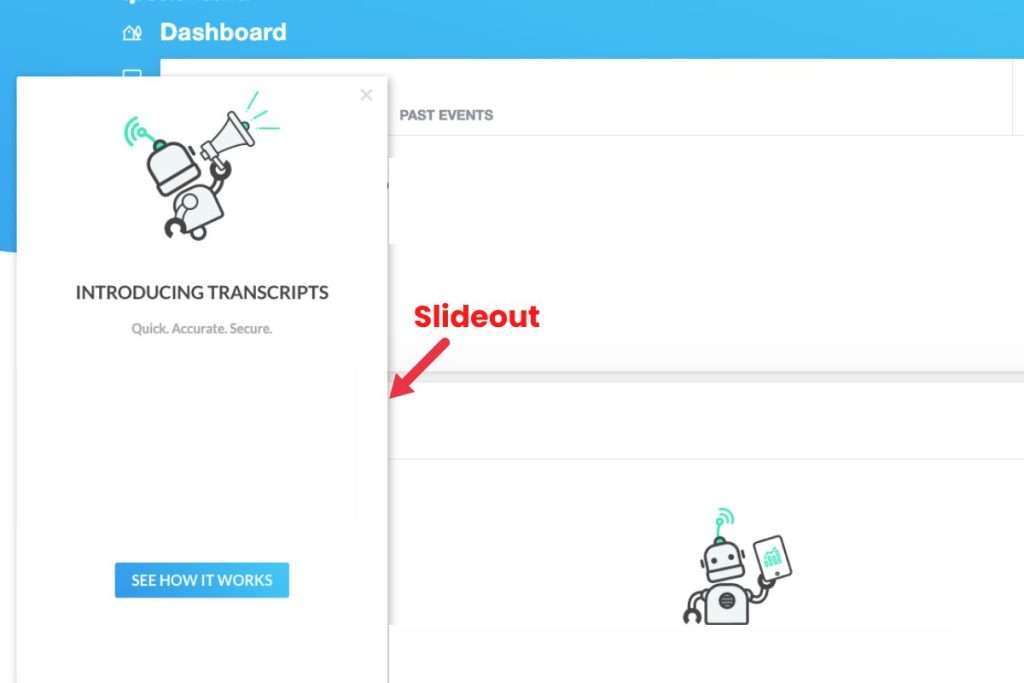
Tooltips are also being used to announce features by companies like Stripe. They are attention-grabbing, effective, and give users immediate access to the new feature.
You can see Stripe using the tool tips to announce a minor feature below:
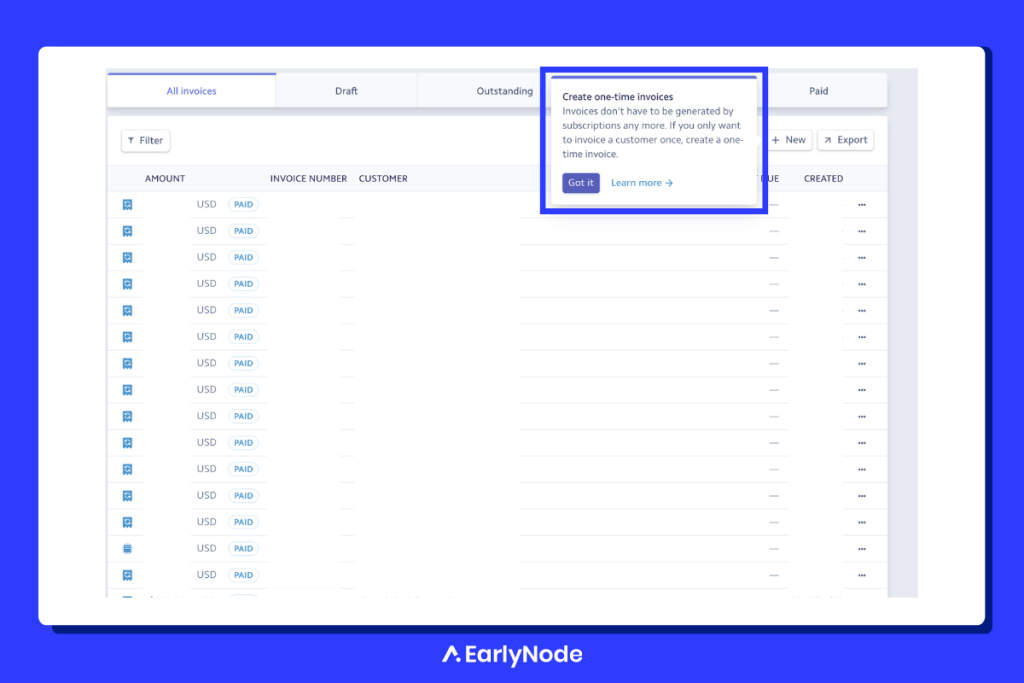
Emails
People still read emails as long as it’s interesting. Emails can be used to give product announcements a personal touch and are commonly used to communicate with users.
While email is still effective you need to be wary of the fact that too many emails could be annoying to your users. So use them to send only important feature releases and improvements.
The best use for email is to send out monthly or quarterly roundups.
Many companies like Loom allow users to subscribe to their changelog posts. This gives them immediate access to users’ inboxes with their consent.
To make your release notes more email-friendly, here’s what you can do:
- Pick the impactful changes and wrap them up as news snippets.
- If you have a detailed dedicated blog for a major feature, link to that in the email.
- End the email with the additional bug fixes or enhancements. (one-liners work best)
- Sprinkle some emojis if it aligns with your brand.
SparkToro’s email updates are snappy and communicate with the user as the focus. That’s why we love it.
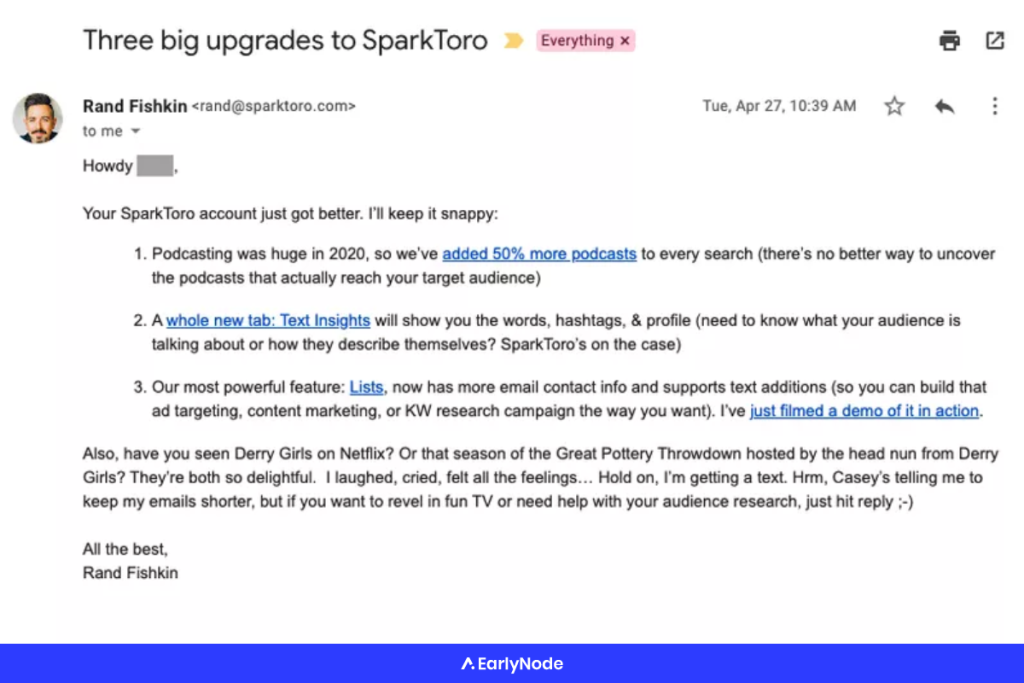
Standalone Changelog
Every SaaS website should have a changelog. But only few are able to effectively use it to drive feature adoption.
You can link to your changelog inside the navigation bar. This will catch the user’s eye whenever they log into your app, getting your announcement in front of the maximum number of users.
Here’s an example of a changelog page from Hopin and their feature announcements:
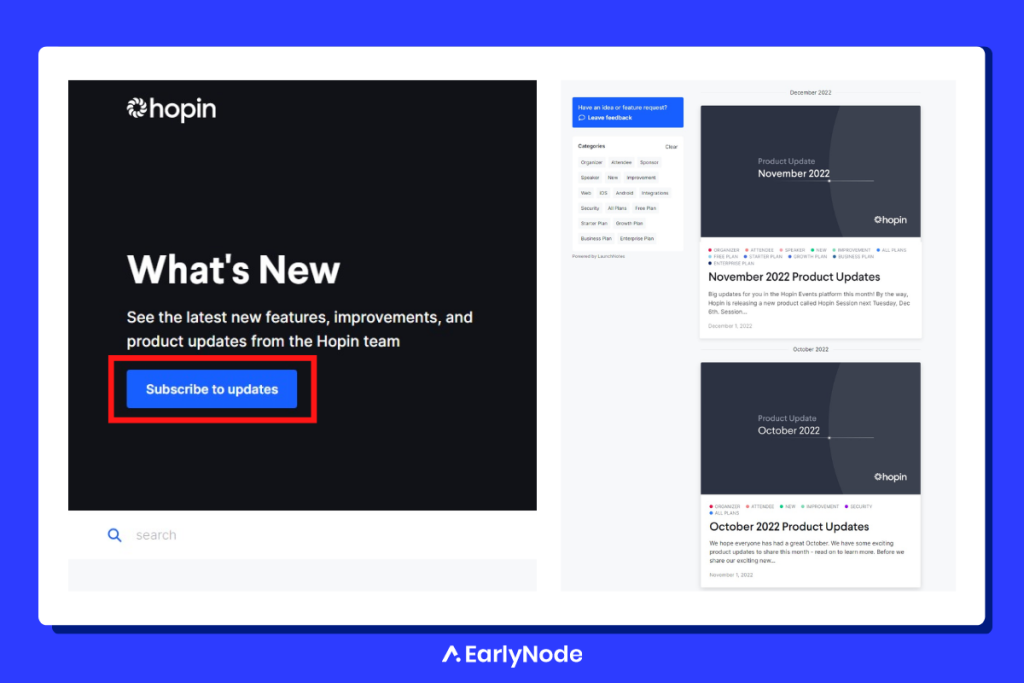
Blog Posts
One of the best ways to communicate your new releases with your audience is by publishing a detailed blog post about them.
For the blog post, it’s better to cover more use cases and examples and provide branded graphics and screenshots so that users can really grasp what the release has introduced.
You can also link these detailed blogs in your release notes as an educational resource.
While writing a release note blog post:
- Stay focused on the user benefits.
- Remove any distracting information.
- Include different ways to get extra help.
Asana uses their blog to attract new users with a value-rich content. Including talking about different use cases of their new feature, like below.
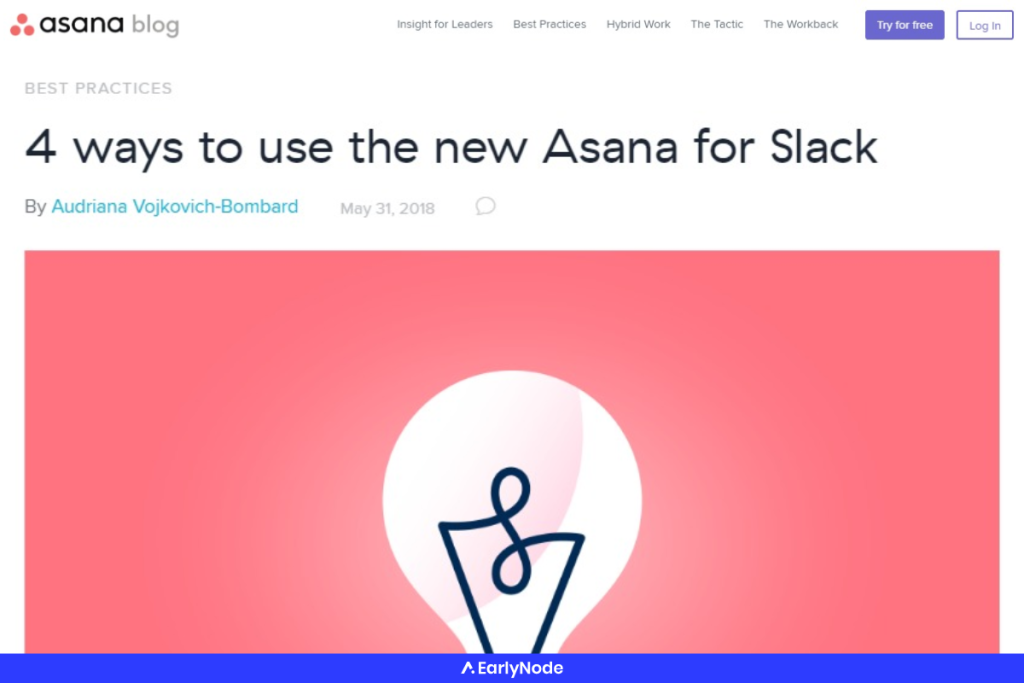
Social Media
You can post custom graphics or videos about your new product updates on social media.
Whether your audience lives on LinkedIn, Twitter, or Facebook, you can reach them easily by posting consistently.
The best thing about social media is that you can attract potential users with the content in your release note.
Try these tips:
- Emphasize each post on a single feature, update, or bug fix.
- Describe how this enhancement affects the user’s experience in 2-3 lines.
- Include a video, graphics, or GIF to show the new feature in action.
Jitter and TeamUp use social media to announce their new features.
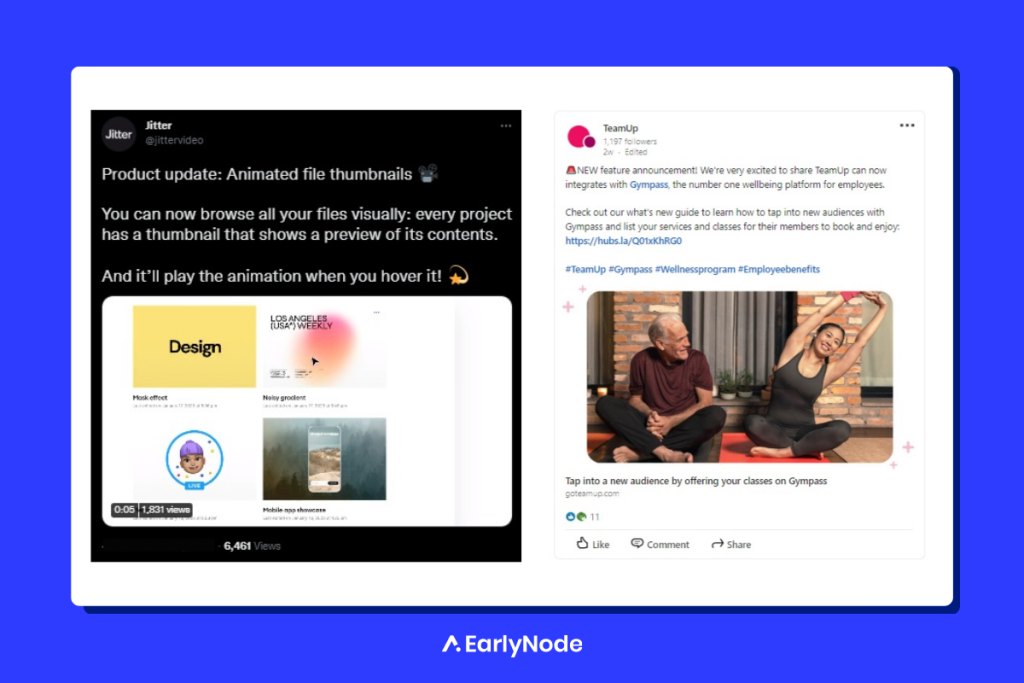
5 Best SaaS Release Notes Examples For Inspiration
Now you have templates and you know where to distribute your release notes. You can draw inspiration some of the big guys in the game.
There aren’t many SaaS companies with release notes as a priority. But we will show you a few companies who are doing it well and why it’s working for them.
Webflow
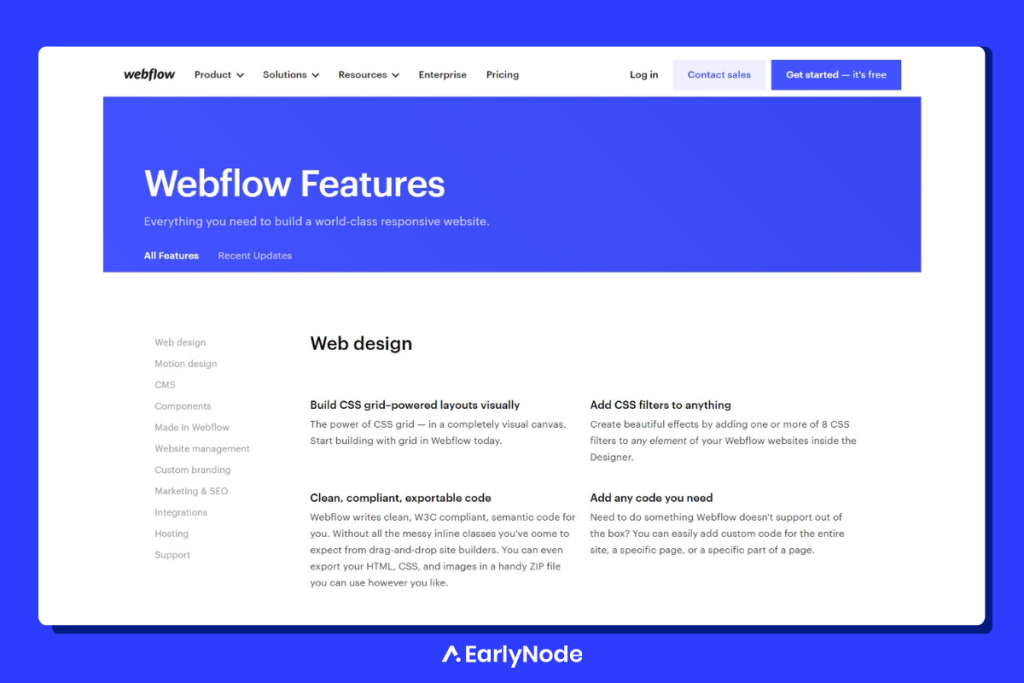
Web flow’s release notes page is built to perfection. Take a look at that wide page filled with white space.
Keeping a clean design clean makes the release notes more readable. Webflow also uses the sidebar for listing labels, making it easier to find specific updates.
ClickUp
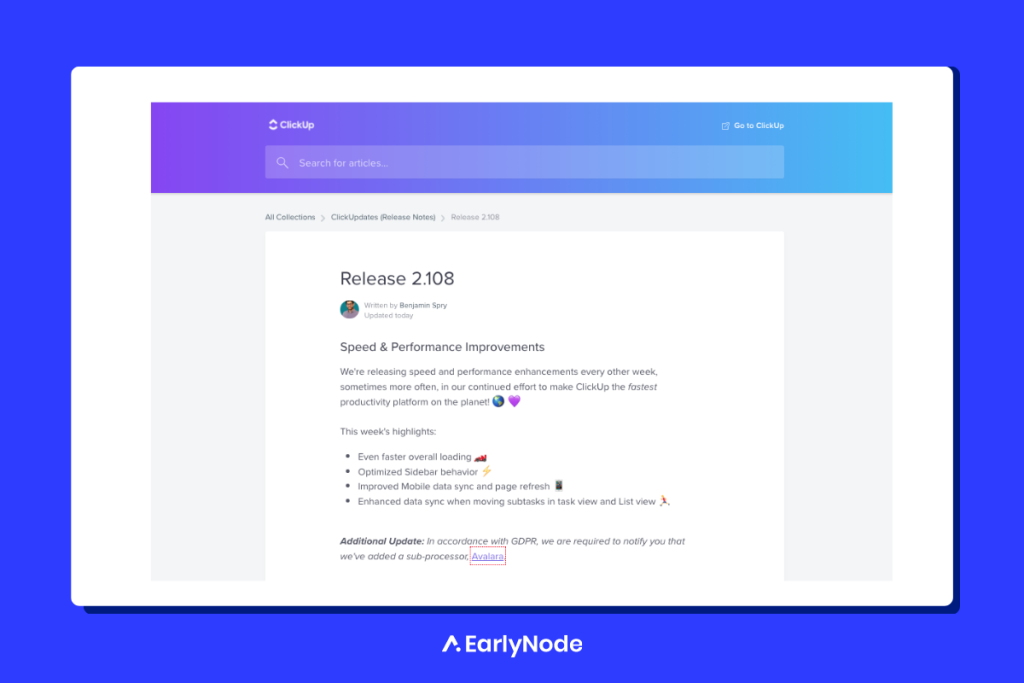
Even though ClickUp ditched the header part, their release notes are still one of the best examples.
ClickUp was creative with their changelog name, calling it “ClickUpdates,”. This makes their users easily recognize their release notes whenever they see it.
Their website design is loaded with a lot of tips:
- Colorful & elegant, consistent with their brand voice.
- It has a lot of blank space too. (see the pattern?)
- The fonts and text sizes are readable.
- They use emojis to make reading more interesting.
Intercom
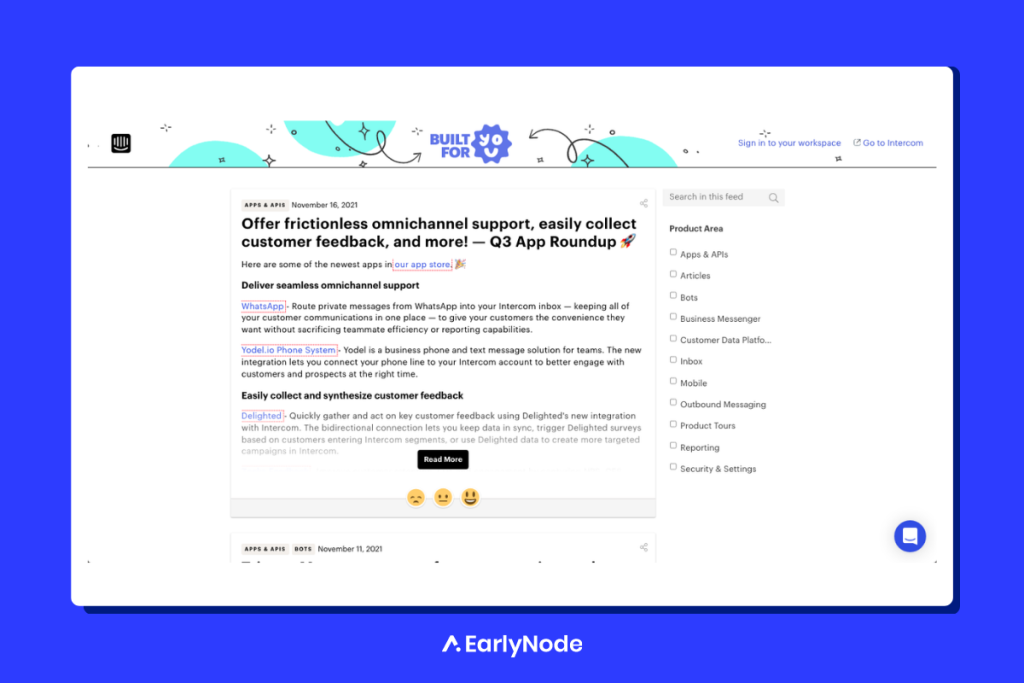
“Built for you” is the title of Intercom’s changelog. This is a perfect example of a customer-centric approach.
Even though the design is compact, you can pick out each update and read the ones that interest you. They provided relevant links to helpful articles. They also use a satisfaction survey at the end of each note, making it easy for users to give quick feedback.
Slack

Slack’s release notes are one of the most popular release notes. They explain the bugs and improvements in a conversational tone to keep their readers interested and engaged. They avoided a lot of technical jargon and also provide external links to the product documentation.
Slack’s release note page is also simple, and it is easy to find what you need with their categorization system.
TeamWork
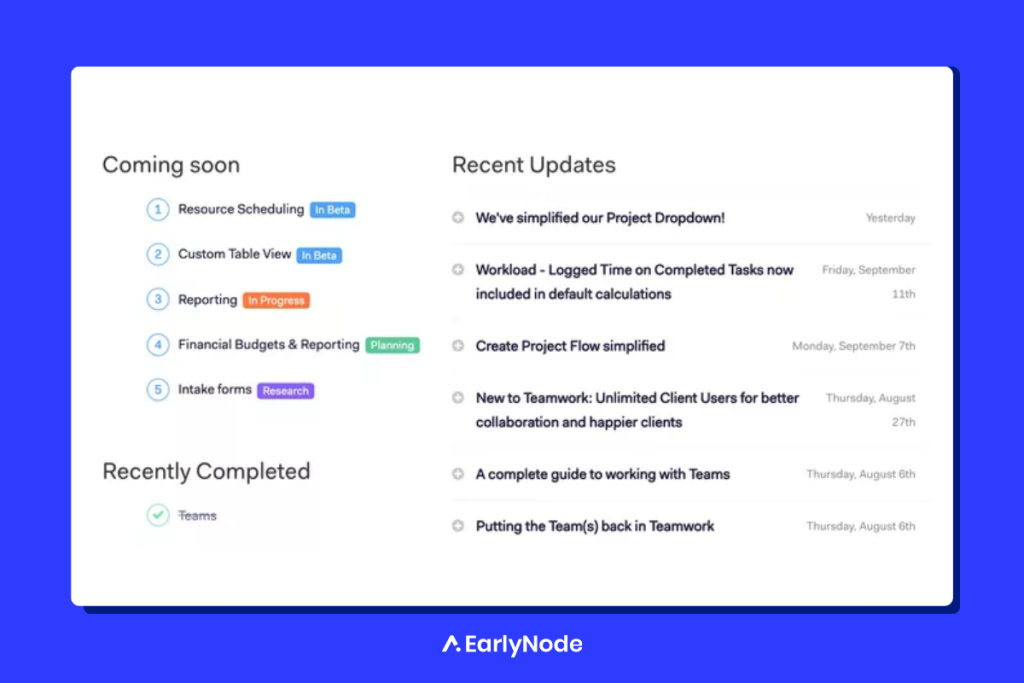
TeamWork, a project management software, goes beyond the traditional way of presenting product roadmap.
They integrated their roadmap into their changelog. This way, users are always up-to-date with what’s changed, what’s in progress, and what’s to come. And they pull it off with a sleek design that does not feel clustered.
Best practices for writing SaaS release notes
Let’s look at the best practices to follow for writing a good SaaS release note:
Technical is boring
Write conversationally and make your release notes enjoyable for your users to read. It should sound more human and less robotic.
User-centric approach:
Release notes should communicate the value of product improvements to your users. List what benefits they are getting from these updates. How are these updates improving their experience with your product?
Educate your users
You have to show your customers how they can reap those benefits. Provide a tutorial video, a link to an external blog post or GIF. Don’t overload anything with too many explanations. Release notes should be relatively easy to skim through.
Use templates
Changing your release notes format with every update might make you appear unreliable and tamper with your brand voice. Keep your structure consistent by using a release notes template.
Feedback is the king
Asking for feedback lets your customers engage with your release notes. It develops trust and also helps get data to improve your product.
Conclusion
Most companies write release notes as an afterthought, an often leave it late until the very last minute. But in the PLG era more companies are beginning to value public changelogs as a user engagement tool to drive adoption.
With the tips we’ve shared you can write effective release notes and be a part of this party. If you want an easy drag-n-drop changelog tool for writing and publishing your release notes, take a look at ReleaseLog. You can get started in less than 5 minutes.
